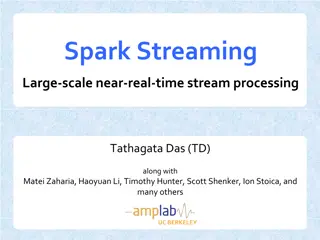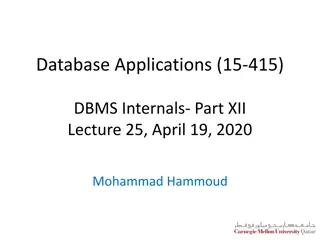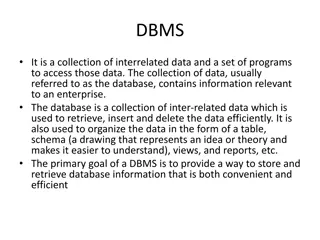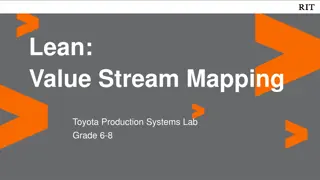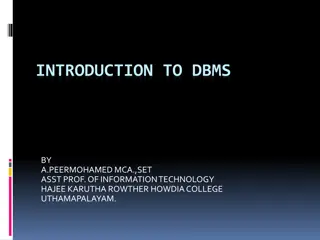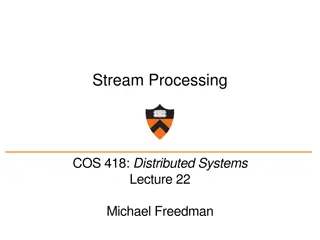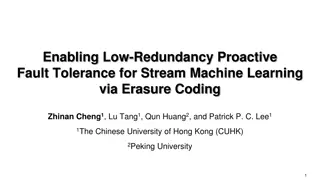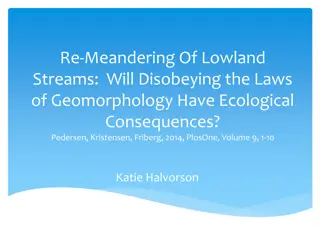Stream Processing in DBMS: Managing Real-Time Data
Stream processing in DBMS involves handling high-speed input data streams efficiently, making critical calculations using limited memory, and executing ad-hoc and standing queries in real-time. Examples include Google search queries, Amazon orders, and satellite image processing. Mining query streams for frequent patterns is essential for tasks like optimal routing and detecting attacks. The model of stream processing revolves around querying recent data elements within a window length, considering scenarios where data cannot be stored entirely in memory.
Download Presentation

Please find below an Image/Link to download the presentation.
The content on the website is provided AS IS for your information and personal use only. It may not be sold, licensed, or shared on other websites without obtaining consent from the author.If you encounter any issues during the download, it is possible that the publisher has removed the file from their server.
You are allowed to download the files provided on this website for personal or commercial use, subject to the condition that they are used lawfully. All files are the property of their respective owners.
The content on the website is provided AS IS for your information and personal use only. It may not be sold, licensed, or shared on other websites without obtaining consent from the author.
E N D
Presentation Transcript
Jeffrey D. Ullman Stanford University/Infolab
In a DBMS, input is under the control of the owner. SQL INSERT commands or bulk loaders. Stream management is important when the input rate is controlled externally. Example: Google search queries. Example: Amazon loves to get orders for products, but does not control when they come in. Example: Satellites send down images, often petabytes/day. More predictable, but too much to deal with efficiently. 2
Input tuples enter at a rapid rate, at one or more input ports. The system cannot store the entire stream accessibly. How do you make critical calculations about the stream using a limited amount of (primary or even secondary) memory? 3
1. Ad-hoc queries: Normal queries asked one time about streams. Example: What is the maximum value seen so far in stream S? 2. Standing queries: Queries that are, in principle, asked about the stream at all times. Example: Report each new maximum value ever seen in stream S. 4
Ad-Hoc Queries Standing Queries . . . 1, 5, 2, 7, 0, 9, 3 Output . . . a, r, v, t, y, h, b Processor . . . 0, 0, 1, 0, 1, 1, 0 time Streams Entering Limited Working Storage Archival Storage 5
Mining query streams. Google wants to know what queries are more frequent today than yesterday. Mining click streams. Yahoo! wants to know which of its pages are getting an unusual number of hits in the past hour. Often caused by annoyed users clicking on a broken page. IP packets can be monitored at a switch. Gather information for optimal routing. Detect denial-of-service attacks. 6
A useful model of stream processing is that queries are about a window of length N the N most recent elements received. Interesting case: N is so large it cannot be stored in main memory. Or, there are so many streams that windows for all do not fit in main memory. 7
q w e r t y u i o p a s d f g h j k l z x c v b n m q w e r t y u i o p a s d f g h j k l z x c v b n m q w e r t y u i o p a s d f g h j k l z x c v b n m q w e r t y u i o p a s d f g h j k l z x c v b n m Past Future 8
Stream of integers, window of size N. Standing query: what is the average of the integers in the window? For the first N inputs, sum and count to get the average. Afterward, when a new input i arrives, change the average by adding (i - j)/N, where j is the oldest integer in the window before i arrived. Good: O(1) time per input. Bad: Requires the entire window in main memory. 9
You can show that if you insist on an exact sum or count of the elements in a window, you cannot use less space than the window itself. But if you are willing to accept an approximation, you can use much less space. We ll consider first the simple case of counting bits. 11
Problem: given a stream of 0s and 1s, be prepared to answer queries of the form how many 1 s in the most recent k bits? where k N. Obvious solution: store the most recent N bits. But answering the query will take O(k) time. Very possibly too much time. And the space requirements can be too great. Especially if there are many streams to be managed in main memory at once, or N is huge. 12
Count recent hits on URLs belonging to a site. Stream is a sequence of URL s. Window size N = 1 billion. Think of the data as many streams one for each URL. Bit on the stream for URL x is 0 unless the actual stream has x. 13
Name refers to the inventors: Datar, Gionis, Indyk, and Motwani. Store only O(log2N) bits per stream. N = window size. Gives approximate answer, never off by more than 50%. Error factor can be reduced to any > 0, with more complicated algorithm and proportionally more stored bits, but the same O(log2N) space reqirement. 14
Each bit in the stream has a timestamp, starting 0, 1, Record timestamps modulo N (the window size), so we can represent any relevant timestamp in O(log2N) bits. 15
A bucket is a segment of the window ending with a 1; it is represented by a record consisting of: The timestamp of its end [O(log N) bits]. The number of 1 s between its beginning and end. Number of 1 s = size of the bucket. Constraint on bucket sizes: number of 1 s must be a power of 2. Thus, only O(log log N) bits are required for this count. 1. 2. 16
Either one or two buckets with the same power-of-2 number of 1 s. Buckets do not overlap. Every 1 is in one bucket; 0 s may or may not be in a bucket. Buckets are sorted by size. Older buckets are not smaller than newer buckets. Buckets disappear when their end-time is > N time units in the past. 17
At least 1 of size 16. Partially beyond window. 2 of size 8 2 of size 4 1 of size 2 2 of size 1 1001010110001011010101010101011010101010101110101010111010100010110010 N 18
When a new bit comes in, drop the last (oldest) bucket if its end-time is prior to N time units before the current time. If the current bit is 0, no other changes are needed. 19
If the current bit is 1: 1. Create a new bucket of size 1, for just this bit. End timestamp = current time. 2. If there are now three buckets of size 1, combine the oldest two into a bucket of size 2. 3. If there are now three buckets of size 2, combine the oldest two into a bucket of size 4. 4. And so on 20
Initial 1001010110001011010101010101011010101010101110101010111010100010110010 1 arrives; makes third block of size 1. 0010101100010110101010101010110101010101011101010101110101000101100101 Combine the oldest two 1 s into a 2. 0010101100010110101010101010110101010101011101010101110101000101100101 Later, 1, 0, 1 arrive. Now we have 3 1 s again. 0101100010110101010101010110101010101011101010101110101000101100101101 Combine the oldest two 1 s into a 2. 0101100010110101010101010110101010101011101010101110101000101100101101 The effect ripples all the way to a 16. 0101100010110101010101010110101010101011101010101110101000101100101101 21
To estimate the number of 1s in the most recent k < N bits: 1. Restrict your attention to only those buckets whose end time stamp is at most k bits in the past. 2. Sum the sizes of all these buckets but the oldest. 3. Add half the size of the oldest bucket. Remember: we don t know how many 1 s of the last bucket are still within the window. 22
Suppose the oldest bucket within range has size 2i. Then by assuming 2i -1of its 1 s are still within the window, we make an error of at most 2i -1. Since there is at least one bucket of each of the sizes less than 2i, and at least 1 from the oldest bucket, the true sum is no less than 2i. Thus, error at most 50%. Question for thought: Is the assumption 2i -11 s are still within the window the way to minimize maximum error? 23
We can represent one bucket in O(logN) bits. It s just a timestamp needing log N bits and a size, needing log log N bits. No bucket can be of size greater than N. There are at most two buckets of each size 1, 2, 4, 8, That s at most log N different sizes, and at most 2 of each size, so at most 2log N buckets. 24
Suppose the input stream is integers in the range 0 to M, and our goal is to estimate the sum of the last k elements in the window of size N. How would you take advantage of the DGIM idea to save space? 25
Viewpoint: what is important in a stream is not just a finite window of most recent elements. But all elements are not equally important; old elements less important than recent ones. Pick a constant c << 1 and let the weight of the i-th most recent element to arrive be proportional to (1-c)i. Weight decays exponentially Now Time 27
Common case: elements are numerical, with ai arriving at time i. The stream has a value at time t: i<t ai(1-c)t-i. Example: are we in a rainy period? ai = 1 if it rained on day i; 0 if not. c = 0.1. If it rains every day, the value of the sum is 1+.9+(.9)2+ = 1/c = 10. Value will be higher if the recent days have been rainy than if it rained long ago. 28
Exponentially decaying windows make it easy to maintain this sum. When a new element x arrives: 1. Multiply the previous value by 1-c. Has the effect of devaluing every previous element by factor (1-c). 2. Add x. 29
Imagine many streams, each Boolean, each representing the occurrence of one element. Example: sales of items. One stream for each item. Stream has a 1 when an instance of that item is sold. Special assumption: streams arrive synchronously, so at any time instance, we can view the set of items whose streams have 1 as a basket. 30
Frequency of an item can be represented by the value of its stream in the decaying-window sense. Frequency of an itemset can be measured similarly by imagining there is a stream that has 1 if and only if all its items appear at a given time. But there are too many itemsets to maintain a value for every possible itemset. 31
Take the support threshold s to be 1/2. I.e., count a set only when the value of its stream is at least 1/2. Start by counting only the singleton items that are above threshold. Then, start counting a set when it occurs at time t, provided all of its immediate subsets were already being counted (before time t). Question for thought: Why not choose s = 1? Or s = 2? 32
1. Suppose set of items S are all the items sold at time t. 2. Multiply the value for each itemset being counted by (1-c). 3. Add 1 to the values for every set T S, such that either: T is a singleton, or Every immediate subset of T was being counted at time t-1. 4. Drop any values < 1/2. 33
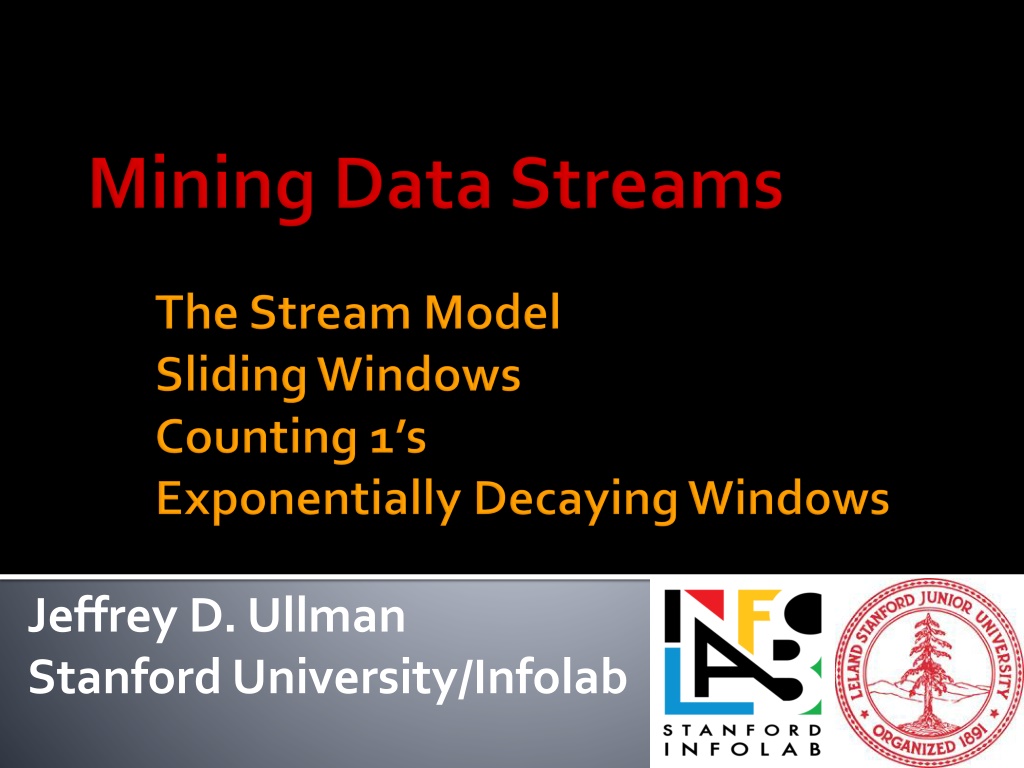
 undefined
undefined








